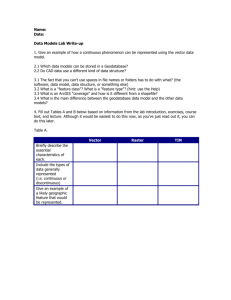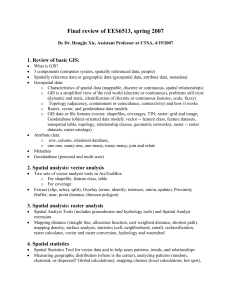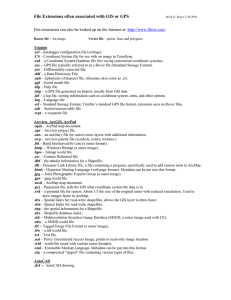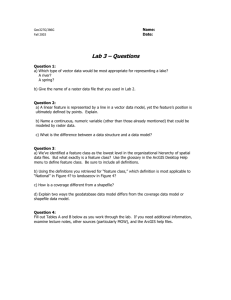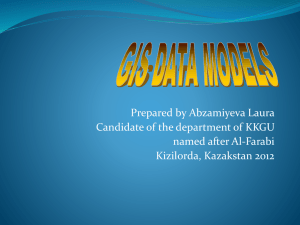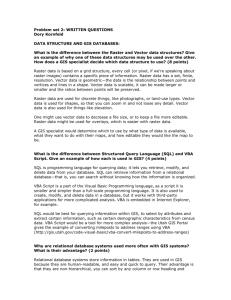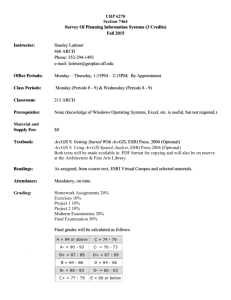Power Point
advertisement
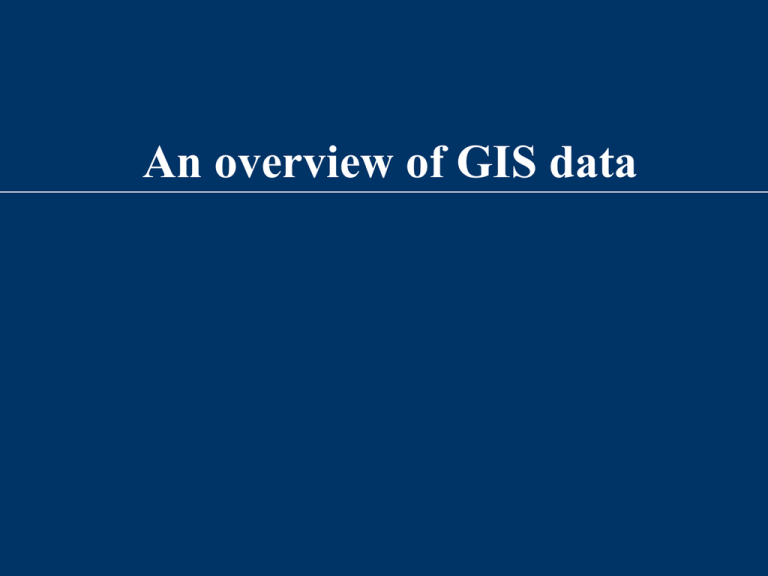
An overview of GIS data Today’s Topic: • GIS Data Models • Data Types • ArcGIS terminology • Review of coordinate systems 2 2 basic types of Data Models • Raster • Vector • Raster GIS • Vector GIS 3 Raster GIS • Raster is nothing but an array of grid cells • Each cell is called Pixel (Picture element) Example: IDRISI, ERDAS, GRASS Pixel Raster DEM (Digital Elevation Model): An example of Raster Data 400 450 500 600 600 300 350 450 400 450 250 200 150 150 400 0 50 100 250 450 5 Raster representation of reservoir and highway 6 Raster GIS • In Raster, each cell is homogeneous • It represents either one class or another, nothing in between • However, in reality, a cell is not one thing or another. 7 Rasterizing of features Mixel Pixel Raster Data • Raster is good for Continuous Data • Continuous Data: When data varies smoothly across the area. Ex: elevation, precipitation, etc. • Raster model provides the best representation for continuously changing data Vector Data • Vector is good for Discrete Data • Discrete Data: When data value remain same for an area and then abruptly changes to another value. • Ex: landuse, soils, etc. Vector GIS Vector GIS is based on POINTS LINES & POLYGONS Example: ArcView, ArcGIS, Manifold, etc. In the vector world everything is a point, a line, or a polygon # # # # # # # # # # # # # # # # # # # # # # # # Points Lines Polygons Vector representation of reservoir and highway 13 GIS Data Most of the available GIS data have been developed using ARC/INFO • Arc/INFO was a flagship product from ESRI • It was widely used all over the world Brief history of ESRI’s GIS software evolution Software Data Format Year Arc/Info Coverage 1980’s ArcView Shapefile 1990’s ArcGIS 8 & 9 Geodatabase 2000’s ArcGIS 10 Geodatabase 2010 Spatial Data Format ArcGIS can work with spatial data in multiple formats • Shapefile • Coverage • Geodatabase • Raster • CAD • Tables Common data formats Coverages Shapefiles Geodatabase Shapefiles A shapefile consists of multiple files, and the common ones are *.dbf, *. shp, *.shx Shapefiles in Windows Explorer Shapefiles in ArcCatalog 2 types of Geodatabase • File geodatabase (soils.gdb-newer type) • Personal geodatabase (soils.mdb-older type) What can be in a Geodatabase • Feature datasets - Collection of related feature classes • Feature classes • Tables • Annotations • Rasters Feature dataset Feature classes Why Geodatabase? It is not only a container of different types of data but also provide enhanced functionalities • Domains • Rules (split and merge policies) • Topological association 33% 66% Other types of data Tables Layer file - Does not contain data - But stores the symbology Layer and Layer file? • A layer represents geographic data displayed in ArcMap • A layer references the data on a disk and keep it in memory rather than storing the data • A layer is created when you add a dataset to ArcMap Layer and Layer file? • Layer is drawn with a default set of drawing properties (symbology) • Layer can be saved to a file as a layer file (.lyr) to store the symbology and shared with others Map Documents 1. When you save a map in ArcMap, it will be saved as a file on disk called map document (.mxd) 2. Map documents (.mxd) do not store the data in it except the link to the data source 3. Map documents make it easy to save, reuse, and share your work in ArcMap More on data • GIS data may be projected or unprojected • Projected or unprojected, GIS data is usually attached to a coordinate system • How do you determine the coordinate system of your data? Two types of coordinate systems Geographic coordinates: • Unprojected • Map units are in decimal degrees Projected coordinates: • Data is projected • Map units are in feet or meters Projected or Unprojected ? Projected/Unprojected? Projected Coordinate Systems (SPC) How do you know the UTM zone of a place?
